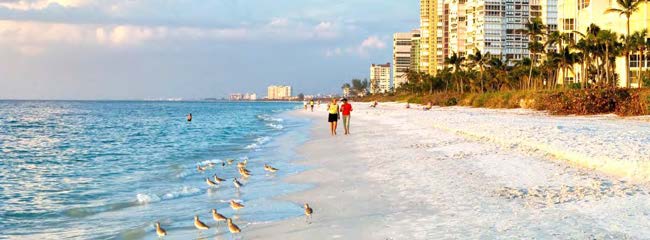Let’s TALK BEACHES by Dave Trecker

How important is our shoreline?
Our beaches and estuaries?
Our boating and fishing?
Collier County Commissioner Andy Solis says, “Our coastline is one of Collier County’s most valuable resources. It’s an integral part of our economy.” Outsiders agree. Last year, WalletHub ranked Naples as America’s number one beach town, beating out contenders from as far away as Hawaii. A recent survey showed that newcomers are drawn here in large part because this is a coastal community. People flock to the shore, and property values near the coast are soaring. Because the shoreline is so special, protecting it is a top priority.
The county’s Coastal Zone Management has been doing that for decades – bringing in sand to fight erosion, restoring dunes, keeping the inlets open, adding groins and jetties where needed. The CZM just completed renourishing portions of the Naples, Vanderbilt and Pelican Bay beaches with 232,000 tons of sand. Wiggins Pass and Doctors Pass were recently dredged. These activities deal with immediate problems, and there are plenty of them. But what about longer term?
The shoreline is becoming increasingly vulnerable. Scientists tell us the sea level could rise by up to 2 feet by 2060, swamping coastal areas. Hurricanes may become more frequent, and storm
surges could send water cascading inland, causing major damage. Compounding the problem, population along the shore is growing as new high-rises and hotels are built and infrastructure
is added to support them. One Naples has been approved, a beachfront expansion at the Naples Beach Hotel & Golf Club is coming and four other new coastal projects are on the drawing boards.
A stunning report by CoreLogic says the Naples metropolitan area is at extreme risk, ranking 9th most vulnerable in the country with a reconstruction cost value of $43 billion. How do we offset this risk – not on a year-by-year basis, but long term? How do we make the coast resilient, protecting buildings and roads? And of no small consequence, how do we protect our tourist business?
Southwest Florida has time. Unlike the Miami area, where higher seawalls and extensive building protection is needed now, the risk to our shoreline is developing gradually. Computer models, though uncertain, suggest we have at least 15-20 years to put protection in place.
The county thought it had a way to do this. A feasibility plan devised by the U.S. Army Corps of Engineers called for massive shoreline strengthening – fortifying beaches; increasing dune heights; selectively hardening with seawalls, groins and surge barriers; flood-proofing buildings and critical infrastructure. The estimated cost was $2.1 billion, with the Federal government picking up 65% of the tab and Collier County the remaining 35%. To put it in play required high-level USACE approval, followed by a Congressional okay and promise of funding. After local input and final design, sand placement could begin as early as 2026.
Where do things stand? Everything is on hold. Because of cost increases, the conclusions of the feasibility study are no longer valid. As a result, USACE planners are petitioning for a two-year extension to revise the plan at a shared cost of $2.5 million. This is a major change that puts the project in jeopardy.
If the do-over proposal is approved, USACE planners have recommended the scope be limited to beach buildup and infrastructure flood-proofing only – no hardening of any kind. That should result in a smaller, faster and far less costly project. It should also overcome concerns of the many stakeholders who objected to beach hardening of any kind.
If the extended study is not approved, a go-it-alone plan drawing on local experts will be crafted in-house. It’s going to take a little longer than expected, but one way or another a viable plan for protecting the shoreline will be coming. Dr. Trecker is chairman of the Coastal Advisory Committee.




Leave a Reply
Want to join the discussion?Feel free to contribute!